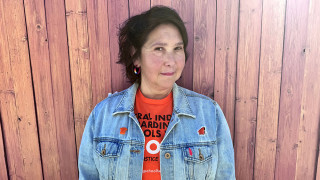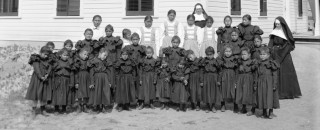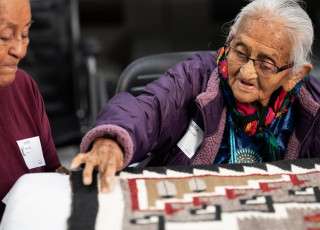Why We Wear Orange: Understanding the Dark History and Persistent Legacy of Indigenous Boarding Schools
This article was first published by the University of Utah College of Social Work in advance of the National Day for Truth and Reconciliation, to be observed at the Natural History Museum of Utah on September 28, 2024. Learn more about the public commemoration that you can attend.
By Dena Ned, PhD, MSW, Director of Indigenous Social Work Scholars, College of Social Work
At the age of 6, Phyllis Webstad, a member of the Stswecem’c Xgat’tem First Nation (Canoe Creek Indian Band), was excited to start school. She proudly wore a brand-new, bright orange shirt her grandmother had bought for her. However, upon arrival at the St. Joseph Mission Residential School in British Columbia, her clothes were stripped away, and her orange shirt was never returned.
“I never wore it again,” recalled Phyllis as an adult. “I didn’t understand why they wouldn’t give it back to me, it was mine! The color orange has always reminded me of that and how my feelings didn’t matter, how no one cared and how I felt like I was worth nothing. All of us little children were crying and no one cared.”
Phyllis’ story highlights the erasure of Indigenous identity and culture that the residential schools enforced, and sparked a grassroots movement that has transcended borders. On September 30, people across North America observe Orange Shirt Day, also known as the National Day for Truth and Reconciliation.

Dena Ned, PhD, MSW, Director of Indigenous Social Work Scholars, College of Social Work.
This day is a powerful reminder of the dark history of the residential school system in Canada and the boarding school era in the United States, both of which aimed to forcibly assimilate Indigenous children into White European cultures. These institutions left profound scars on Indigenous communities, shaping their present-day challenges and resilience.
From a social justice perspective, acknowledging this history is vital to healing the generational trauma it caused and addressing the systemic inequities that persist.
Similar to Canada's residential schools, the United States also had a network of boarding schools designed to assimilate Native American children. These schools were operational from the late 1800s until the mid-20th century, and their legacy is just as damaging. Children were often forcibly taken from their families and sent hundreds or thousands of miles away to boarding schools, where they were stripped of their cultural identity—language, spiritual practices, traditional clothing—and, in many cases, subjected to harsh physical and emotional abuse.
Somehow, that wasn’t the worst of it. At least 973 children died while attending Indigenous boarding schools, according to a 2024 report from the U.S. Department of the Interior. Because so many unmarked burial sites have been discovered on the grounds of former boarding schools, many believe the true number of lost Indigenous children is actually much higher.
To this day, the lasting trauma of these experiences continues to impact not only the living survivors of the schools, but also their children, grandchildren, and great-grandchildren.
In 2021, Canada officially declared September 30 the National Day for Truth and Reconciliation. While Orange Shirt Day began in Canada, its significance transcends borders, resonating with Indigenous Peoples and their allies globally. The movement has grown into a day of education and awareness, emphasizing the need to reflect on the colonial policies that led to the establishment of residential and boarding schools.
Understanding the historical context of Orange Shirt Day and the boarding school era is essential for both healing and pursuing reconciliation.
Generations of Indigenous families were profoundly impacted by this system. Research has shown the trauma of abuse and neglect in these schools has contributed to high rates of behavioral, mental, and physical health issues across generations. Indigenous languages have faced near extinction, and many communities lost their ability to pass on cultural traditions and spiritual practices. While some survivors of these schools have shared their experiences, many others have carried the weight of this history in silence. Residential and boarding schools represent not only a history of oppression, but also the ongoing legacy of colonization, cultural erasure, and intergenerational trauma.
This is why the National Day for Truth and Reconciliation is about both remembering the past and advocating for systemic change in the present.
Public commemoration of this often-ignored history and its lasting impacts is vital to the reconciliation process. Orange Shirt Day is an opportunity for people to educate themselves about the lived experiences of Indigenous Peoples and to reflect on the role that governments, institutions, and individuals have played in perpetuating injustice. To be a part of reconciliation and healing, our communities must actively engage in learning and unlearning the colonial narratives that have shaped mainstream history.
As an Indigenous social worker, I know that the National Day for Truth and Reconciliation is more than commemorating a tragic history—it is about fostering understanding, justice, and healing. It is our collective responsibility to ensure that future generations inherit a legacy of healing, not harm.
National Day for Truth and Reconciliation at NHMU
Please join Dr. Ned at the Natural History Museum of Utah on Saturday, September 28, 2024 from 11 a.m. - 1:30 p.m., for a public remembrance for the victims of the American Indian Boarding School era, helping drive awareness of the intergenerational impacts the program inflicted on individuals, families, and communities. A ceremony will honor the healing journey of survivors, their families, and those who never made it home. It will be followed by a film screeing of Remember the Children and a panel discussion featuring indigenous elders and experts. Panelists and organizers encourage you to wear orange shirts if you are attending the commemoration on September 28, and again on September 30.

